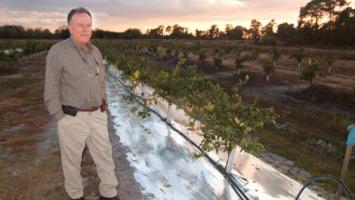http://southeastfarmpress.com/orchard-crops/silver-bullet-citrus-greening
A silver bullet for citrus greening?
CHARLES JOHNSON
Feb. 2, 2012 12:32pm
 PHIL STANSLY, University of Florida Immolakee entomologist,
PHIL STANSLY, University of Florida Immolakee entomologist,
checks trials evaluating silver mulch for control of citrus psyllid.
A simple silver plastic mulchmay deter citrus psyllid from landing on young trees most susceptible to the greening disease it vectors.
Tests at the University of Floridas Southwest Florida Research & Education Center at Immokalee show reduced greening in young trees on the silver mulch compared to those on white mulch or grass.
We know that psyllids cant find the trees well on silver mulch. Theyre confused by the reflected light, says Phil Stansly, an entomologist at the station.
The difference in psyllid counts between the silver mulch and white mulch or grass is like day and night, says John Dunckelman, director of the center. The silver mulch is having a repellent effect or some sort of disruption in the psyllid.
The mulch is like that used in vegetable crops and, and aside from helping with the psyllid, provides other benefits like weed control and moisture retention. For the researchers, however, its impact on greening is most promising.
The psyllid finds the treeby vision, during daytime. It goes to sleep on the plant at night. The effect from the silver mulch may have something to do with causing a contrast with the background. On the white mulch, the psyllids can find the plant. On silver mulch, they seem to have a problem doing that, Stansly says.
Were really interested in finding out more about it. Its worthy of more experiments. Weve got big plans for it, Dunckelman says.
Bob Rouse, citrus horticulturist at the Immokalee station, is impressed with the tests on the silver, or aluminum, mulch.
It has real potential, Rouse says. It does seem to disrupt the flight pattern of the psyllid. I think growers are going to start using the silver mulch on new plantings.
How about on bigger trees?
On the older stuff, I dont know. When the canopy is big enough, it shades enough that the reflection from the silver mulch may not disrupt the psyllid. The logistics of how to get enough of the ground covered in an efficient way may be difficult. If that gets worked out, we may see groves with silver mulch over most of the ground.
Protecting young trees from greening is most important, however.
The young tree is most susceptible to greening. What growers have to do is get the tree to a size where its more tolerable of greening. Young trees are vigorous and growing and attract the psyllid to that new growth. Big trees only flush at certain times of the year. The big trees are not very attractive to the psyllid the rest of the year.
Researchers are learning moreabout the psyllid, which carries the bacteria that causes greening in its gut, spreading it from tree to tree. It can produce up to 800 eggs that can take two weeks to develop under optimal conditions, Stansly says.
In warm weather, the adults live only two-to-three weeks. A psyllid can live through the winter months, however, and start the life cycle over again in spring.
It will lay eggs in the flush and there it goes again, Stansly says.
He is unsure how far and fast the psyllid can spread.
Its kind of like whitefly. How does the wind blow? As long as it can survive up in the wind current, it can get around, Stansly says.
Stansly is developing a method of sampling for psyllid to determine infestation level. He calls it a top sampling technique. He sweeps a PVC pipe across the trees limbs, holding a white laminated clipboard underneath. Psyllids fall on the clipboard and the sampler quickly counts them. The method could help in determining an economic threshold for the psyllid.
So far, the researchers have not established an economic threshold, however.
Were just using arbitrary levels in our research, Stansly says.




